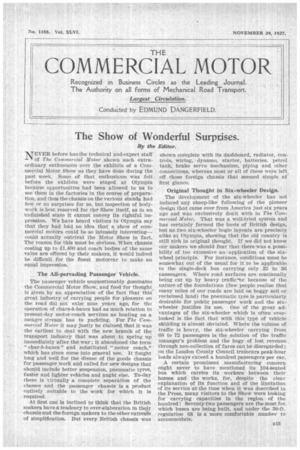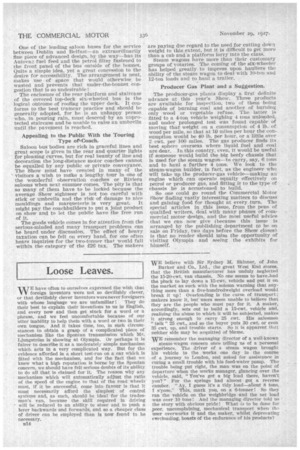COMMERCIAL MOTOR
Page 39

Page 40

If you've noticed an error in this article please click here to report it so we can fix it.
Recognized in Business Circles as the Leading Journal. The Authority on all foerris of Mechanical Road Transport.
Largest Circulation.,
Conducted by EDMUND DANGERFIELD.
The Show of Wonderful Surprises.
By the Editor.
NEVER before has the technical and expert staff of The Commercial Motor shown such extraordinary enthusiasm over the exhibits of a C0711mercial Motor Show as they have done during the past week. Some of that enthusiasm was felt before the exhibits were staged at Olympia because opportunities had been allowed to us to see them in the factories in the course of preparation, and thus the chassis on the various stands had few or no surprises for us, but inspection of bodywork is best reserved for the Show itself, as in an unfinished state it cannot convey Its rightful impression. We have heard visitors to Olympia say that they had had no idea that a show of commercial motors could be so intensely interesting-could actually outri-val. the Motor Show in fact. The reason for this must be obvious. When chassis costing up to £1,400 and coach bodies of the same value are offered by their makers, it would indeed be difficult for the finest motorcar to make an equal impression.
_ The All-pervading Passenger Vehicle.
• The passenger vehicle unquestionably dominates the Commercial Motor Show, and food for thought, is given by an appreciation of the fact that this great industry of carrying people for pleasure on the road did not exist nine years ago, for the operation of chars-asbancs had as much relation to present-day motor-coach services as boating on a meagre stream has to yachting. For The Cornmercial Motor it may justly be claimed that it was the earliest to deal with the new branch of the transport industry that was about to spring up immediately after the war ; it abandoned the term " char-A-bancs" and substituted "motor coach,". which -has since come into general use. It fought long and well for the disuse of the goods chassis for passenger work and called for new designs that should include better suspension, pneumatic tyres, faster and lighter vehicles and aught else. To-day there is virtually a complete separation of the classes and the passenger chassis is a product entirely suitable to the work for which it is required.
At first one is inclined to think that the British makers have a tendency to over-elaboration in they chassis and the foreign makers to the other extrente of simplification. But every British chassis was shown complete with its dashboard, radiator, controls, wiring, dynamo, starter, batteries, petrol tan*, brake servo mechanism, piping and other connections, whereas most or all of these were left off those foreign chassis that seemed simple at first glance.
Original Thought in Six-wheeler Design.
The development of the six-wheeler has not induced any sheep-like following of the pioneer design that came over from America just six years ago and was exclusively dealt with in The Commercial Motor. That was a well-tried system and has certainly formed the basis of British design, but no-two six-wheeler bogie layouts are precisely alike at Olympia, showing that the old country is still rich in original thought. If we did not know our makers we should fear that there was a possibility of too extensive an application of the sixwheel principle. For instance, conditions must be somewhat out of the usual for it to be applicable to the single-deck bus carrying only 32 to 36 passengers. Where road surfaces are continually being cut up by heavy traffic-or because of the nature of the foundations (few people realize that many miles of our roads are laid on boggy soil or reclaimed land) the pneumatic tyre is particularly desirable for public passenger work and the sixwheeler justifies its use. One of the great advantages of the six-wheeler which is often overlooked is the fact that with this type of vehicle skidding is almost obviated. Where the volume of traffic is heavy, the six-wheeler carrying from 68 to 72 passengers is the solution of the traffic manager's problem and the bogy of lost revenue. • through non-collection of fares can be disregarded ; on the London County Council tramcars peak-hour loads always exceed a hundred passengers per car.
A certain prominent manufacturing concern ought never to have mentioned its 104-seated bus which carries its workers between their homes and the works, for, despite the clear explanation of its function and of the limitation of its service at the time when it was described in the Press, many visitors to the Show were looking for carrying capacities in the region of the hundred! Seventy-two passengers are the most for, which buses are being built, and under the 30-ft. regulation 68 is a more comfortable number to accomm oils te. One of the leading saloon buses for the service between Dublin and Belfast—an extraordinarily fine piece of advanced design, by the way—has its Autovac fuel feed and the petrol filter fastened to the front panel of the bus outside of the bonnet. Quite a simple idea, yet a great concession to the desire for accessibility. The arrangement is neat, Makes use of space that would otherwise be wasted and prevents that under-the-bonnet congestion that is so undesirable The enclosure of the rear platform and staircase of the covered top-deck six-wheeled bus is the logical outcome of roofing the upper deck. It conforms to the best tramcar practice and should be generally adopted, for he is an unhappy person who, in pouring rain, must descend by an unprotected staircase and be unable to raise an umbrella until the pavement is reached.
Appealing to the Public With the Touring Type of•Coach. • Saloon bus bodies are rich in graceful lines and great scope is given in the rear and quarter lights for pleasing curves, but for real beauty of line and decoration the long-distance motor coaches cannot be equalled by any public or private conveyance. The Show must have created in many of the visitors a wish to make a lengthy tour in one of the wonderful observation coaches or Riviera saloons when next summer comes. The pity is that so many of them have to be locked because the average Show sightseer is not too Careful with stick or umbrella and the risk of damage to nice mouldings and rnarqueterie is very great. It might pay the coachbuilclers to put a joint product on show and to let the public have the free run of it.
The goods vehicle comes in for attention from the serious-minded and many transport problems can be heard under discussion. The effect of heavy taxation can be felt on every hand, for one often hears inquiries for the' two-tonner that would fall within the category of the f26 tax. The makers
are paying due regard to the need for cutting down weight to this extent, but it is difficult te get more than a cab and a platform lorry into the class.
Steam wagons have • more than their customary groups of•votaries. The coming of the six-wheeler has helped greatly to impress upon hauliers the ability of the steam wagon to deal with 10-ton a.nd 12-ton loads and to haul a trailer.
Producer Gas Plant and a Suggestion.
The producer-gas plants display a first definite
• advance at this year's Show. Three products are available for inspection, two of them being capable of burning coal and another of burning only wood or vegetable refuse. The latter is fitted to a 4-ton vehicle weighing 4 tons unloaded, and under prelonged test was found capable of moving that weight on a consumption of 4 lb. of wood per wile, so that at 1.0 miles per hour the consumption would be 40 lb. per hour, or a little over 2 cwt. per 1.00 miles. The gas producer finds its best sphere overseas where liquid fuel and coal are dear. In this country, even, it would be useful if someone would build the big beefy chassis that is used for the steam wagon—to carry, say, 6 tons and to haul a further 4 tons. We look to the steam-wagon builder, in fact, as the engineer who will take up the producer-gas vehicle—making an engine which can operate equally effectively on petrol or producer gas, and fitting it to the type of chassis he is accustomed to build.
So one could go round the Commercial Motor Show finding vastly Interesting matters to discuss and gaining food for thought at every turn. The special articles in this issue, from the pens of qualified writers, deal with many phases of commercial motor design,, and the most useful 'nth-ice that we can now give (because this issue is arranged by the publishing department to be on sale on Friday, two days before the Show closes) is that no reader should miss the opportunity of visiting Olympia and seeing . the exhibits for himself.




















































































































